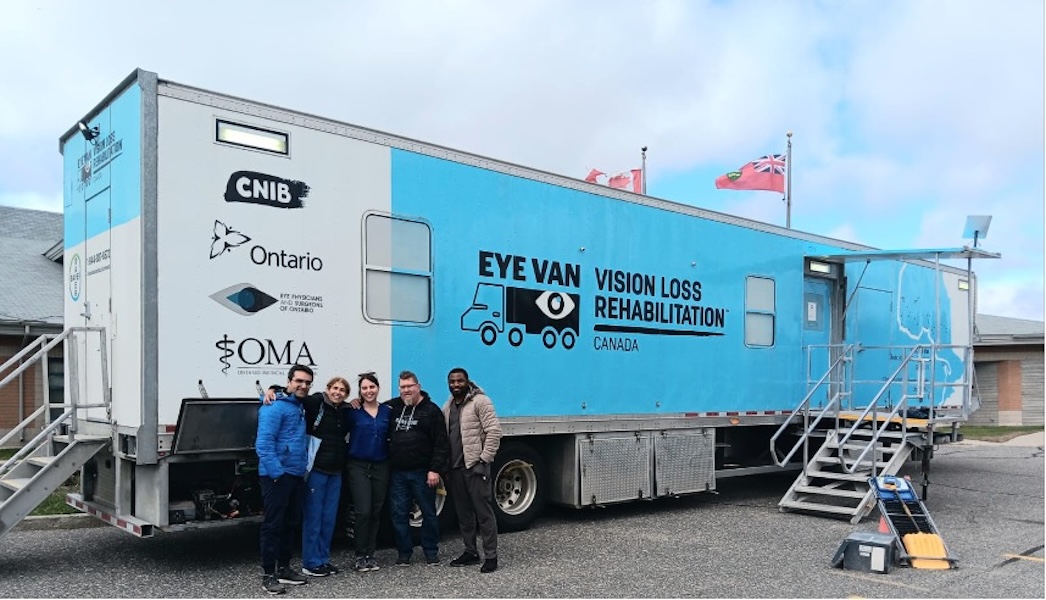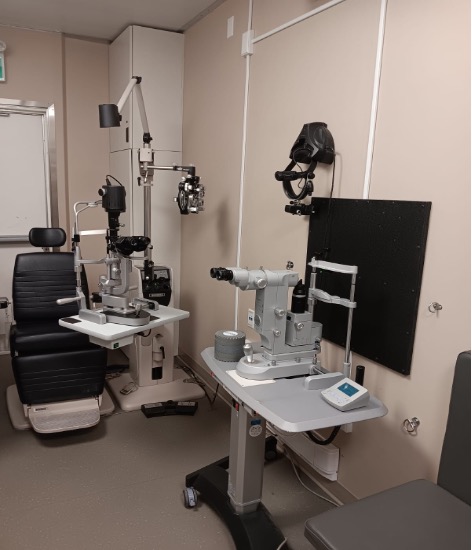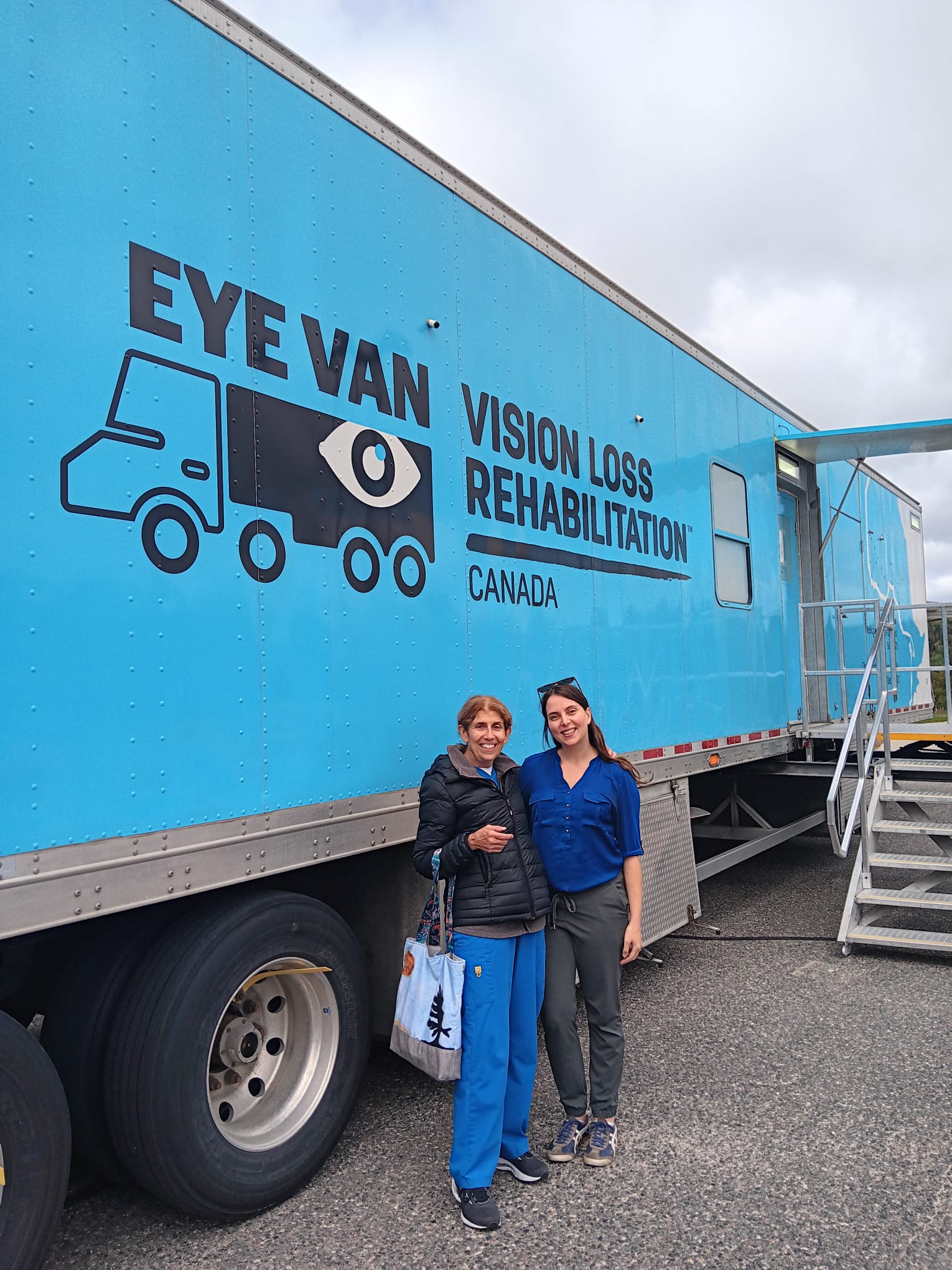Natalie Mezey, a medical student at Queen's University, is an Affiliate Member of the Research Excellence Cluster in Vision. In the summer of 2024, she returned to volunteer with the Vision Loss Rehabilitation Canada Eye Van, a fully equipped, mobile eye clinic that travels more than 6,000 kilometres annually to provide service to people in remote regions of Northern Ontario.

By: Natalie Mezey

A train, a flight and a 4-hour drive north from a major airport, so began my journey to a remote northwestern Ontario community. This was my second-year volunteering on the VLRC Eye Van, but because we were heading to a different location even more remote than the previous year, I was unsure what surprises would await us. Dr. Myrna Lichter, a comprehensive ophthalmologist and Director of Public Health and Global Ophthalmology at the University of Toronto had never been on the Eye Van before. She was as excited as I was to see how eye care was delivered in communities with no access to physicians. Whenever I am heading to a new place I’ve never been to, I always try to imagine what brought people there and more importantly what makes them stay. We expected a long and somewhat dull drive from the airport, but as soon as we left the city limits, it became clear to Dr. Lichter and I the reasons why some have decided to settle in the remote northern location. Endless forests, hills, rivers, and lakes dotted our road as far as the eye could see, with each view from our windows more gorgeous than the last. As an outdoors and hiking fanatic, for me, the draw was clear.
There were many patients waiting for the annual visit of the VLRC Eye Van. So much so that we had about 38 patients to see daily, from 8am staying as late as 7pm with few to no breaks. There were others in the community who hadn’t known about us until they saw the big blue transport truck come into town. We had some scheduled patients ask if their brother, husband, or wife who had no appointment could also be squeezed in. We even had a coffee shop owner who saw us pull up ask if her relative could be squeezed in. It was clear the need was great and Dr. Lichter and the entire Eye Van team, including the driver and the two ophthalmic assistants, worked tirelessly to ensure every patient was seen.
We didn’t expect to see such a range of vision-threatening disease in such a small community, and it became clear that the Eye Van was a much-needed resource for prevention of disease progression and vision loss. We saw patients living with diabetes, glaucoma, cataracts, and macular degeneration. Many of these patients had no idea they had these conditions, and it was important for us to carefully explain the condition and management because we knew we would not be around to follow them. Patient education was a big part of what we did on the Eye Van.

We also were surprised to encounter complex neurological conditions. We saw a progressive supranuclear palsy in a patient who had only had virtual care until then. There were also lid abnormalities such as ectropion, entropion as well as advanced cataracts that needed surgical intervention. The team worked hard to ensure a referral was sent to the appropriate specialists and a few patients were referred to surgeons or retina specialists in cities that were 2 to 4 hours away by car.
From our perspective, this was the biggest challenge of healthcare in this community, the need to find a provider and drive great distances for surgery or regular injections for retinopathy. Astonishingly, none of the patients complained of this reality. We expected much protest when apologetically informing them that they would need to drive to get further care. However, there was a sense of acceptance of their reality, and they didn’t seem significantly bothered by these geographical limitations. They were tremendously grateful for the care the Eye Van provided and seemed to accept that more complex management would need to be done in a larger city.
Sometimes finding the right provider for follow-up of our patients was a challenge. We were a 2 hours’ drive from the nearest cataract surgeon and a 4 hours’ drive from the nearest optometrist for glasses fittings. When we encountered complex strabismus cases needing prisms, that evening we spent time looking up all optometrists within a 4-hour drive to try and find an appropriate provider who could take the time to carefully fit these patients.
In the back of our minds, we were always thinking what can wait a year? What condition can be watched once a year and what needs more immediate or regular intervention? Dr. Lichter often found herself saying, “If you were in Toronto, I’d see you next week or in a month, or 2 months but I can’t and so we have to find another solution.” For conditions like Blepharitis and dry eye, she would typically trial different drops and different strategies in a stepwise fashion however this was simply not possible. On the other hand, many sight-threatening conditions were caught and managed on the Eye Van. Possible Glaucoma patients were screened and treated as needed. People who otherwise would be not aware that they have sight threatening conditions such as macular degeneration (AMD) were screened and treated. Many AMD patients were given educational pamphlets and critical vitamins, and counselling on smoking cession to prevent disease progression.

I was also very surprised by the diversity of the community we were in. There were many Francophone patients, a rare treat for me to speak French coming from Kingston where most patients are English-speaking. One patient who had moved to this small northern town from sunny California. As a Polish speaker, I also had a rare opportunity to translate for an old Polish patient who barely spoke English. He was so touched by this that he came back a few hours later with a big box of Polish treats.
We saw first-hand the impacts that the Eye Van had on the community. We fantasized about doing even more and we joked that if we had a magic wand, we would provide even more services such as glasses fittings and cataract surgeries. This experience had us dreaming big. What struck us the most is how grateful, patient and accepting of their situation patients were, something we felt we could do better at applying to our own busy, city lives. So, while we were giving to the community, the community certainly gave back so much to us.
